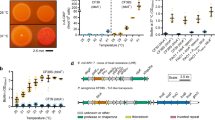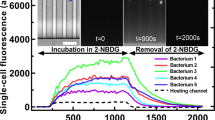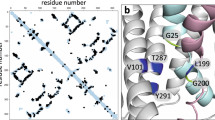Abstract
We observed that bacteria grown below a critical concentration, in batch-mode cultures, swim towards warm regions when subjected to a temperature gradient. Above that concentration, they swim towards colder regions. Our findings indicate that the secreted intercellular signal, glycine, mediates this switch through methylation of Tsr receptors. At high bacterial concentration, the switch is reinforced by an inversion of the Tar/Tsr expression ratio.
This is a preview of subscription content, access via your institution
Access options
Subscribe to this journal
Receive 12 print issues and online access
$209.00 per year
only $17.42 per issue
Buy this article
- Purchase on Springer Link
- Instant access to full article PDF
Prices may be subject to local taxes which are calculated during checkout


Similar content being viewed by others
References
Imae, Y. Sensing and Response in Microorganisms (eds Eisenbach, M. & Balaban, M.) 73–81 (Elsevier, New York, 1985).
Berg, H. C. E. coli in motion (Springer, New York, 2003).
Mesibov, R. & Adler, J. J. Bact. 112, 315–326 (1972).
Alon, U., Surette, M. G., Barkai, N. & Leibler, S. Nature 397, 168–171 (1999).
Korobkova, E., Emonet, T., Vilar, J. M. G., Shimizu, T. S. & Cluzel, P. Nature 428, 574–578 (2004).
Kollmann, M., Løvdok, L., Bartholomé, K., Timmer, J. & Sourjik, V. Nature 438, 504–507 (2005).
Mello, B. A. & Tu, Y. Proc. Natl Acad. Sci. USA 102, 17354–17359 (2005).
Park, S. et al. Proc. Natl Acad. Sci. USA 100, 13910–13915 (2003).
Staropoli, J. F. & Alon, U. Biophys. J. 78, 513–519 (2000).
Tomasz, A. Nature 208, 155–159 (1965).
Stewart, R. C. & Dahlquist, F. W. Chem. Rev. 87, 997–1025 (1987).
Maeda, K. & Imae, Y. Proc. Natl Acad. Sci. USA 76, 91–95 (1979).
Mizuno, T. & Imae, Y., J. Bact. 159, 360–367 (1984).
Jasuja, R., Keyoung, J., Reid, G. P., Trentham, D. R. & Khan, S. Biophys. J. 76, 1706–1719 (1999).
Nishiyama, S. I., Umemura, T., Nara, T., Homma, M. & Kawagishi, I. Mol. Microbiol. 32, 357–365 (1999).
Acknowledgements
We thank David S. Thaler, Lee M. Kiang and Yuhai Tu for their helpful advice. We also thank Oliver Dreesen and the Hemmati Brivanlou Laboratory for their help with the real-time PCR. For the gift of mutant bacteria, we are grateful to the labs of Robert H. Austin and Jeffery B. Stock from Princeton University, New Jersey.
Author information
Authors and Affiliations
Corresponding author
Ethics declarations
Competing interests
The authors declare no competing financial interests.
Supplementary information
Supplementary Information
Supplementary Figure S1 and Material and Methods (PDF 305 kb)
Rights and permissions
About this article
Cite this article
Salman, H., Libchaber, A. A concentration-dependent switch in the bacterial response to temperature. Nat Cell Biol 9, 1098–1100 (2007). https://doi.org/10.1038/ncb1632
Received:
Accepted:
Published:
Issue Date:
DOI: https://doi.org/10.1038/ncb1632
This article is cited by
-
A Mathematical Description of Bacterial Chemotaxis in Response to Two Stimuli
Bulletin of Mathematical Biology (2022)
-
Auxotrophy to Xeno-DNA: an exploration of combinatorial mechanisms for a high-fidelity biosafety system for synthetic biology applications
Journal of Biological Engineering (2018)
-
Chemotaxis of Escherichia coli to major hormones and polyamines present in human gut
The ISME Journal (2018)
-
Disorder-mediated crowd control in an active matter system
Nature Communications (2016)
-
Effect of gold nanoparticles on thermal gradient generation and thermotaxis of E. coli cells in microfluidic device
Biomedical Microdevices (2016)



